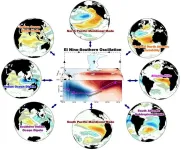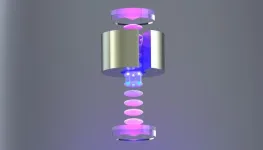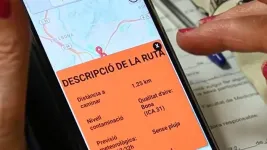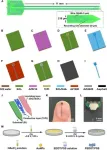(Press-News.org) As lasers go, those made of Titanium-sapphire (Ti:sapphire) are considered to have “unmatched” performance. They are indispensable in many fields, including cutting-edge quantum optics, spectroscopy, and neuroscience. But that performance comes at a steep price. Ti:sapphire lasers are big, on the order of cubic feet in volume. They are expensive, costing hundreds of thousands of dollars each. And they require other high-powered lasers, themselves costing $30,000 each, to supply them with enough energy to function.
As a result, Ti:sapphire lasers have never achieved the broad, real-world adoption they deserve – until now. In a dramatic leap forward in scale, efficiency, and cost, researchers at Stanford University have built a Ti:sapphire laser on a chip. The prototype is four orders of magnitude smaller (10,000x) and three orders less expensive (1,000x) than any Ti:sapphire laser ever produced.
“This is a complete departure from the old model,” said Jelena Vučković, the Jensen Huang Professor in Global Leadership, a professor of electrical engineering, and senior author of the paper introducing the chip-scale Ti:sapphire laser published in the journal Nature. “Instead of one large and expensive laser, any lab might soon have hundreds of these valuable lasers on a single chip. And you can fuel it all with a green laser pointer.”
Profound benefits
“When you leap from tabletop size and make something producible on a chip at such a low cost, it puts these powerful lasers in reach for a lot of different important applications,” said Joshua Yang, a doctoral candidate in Vučković’s lab and co-first author of the study along with Vučković’s Nanoscale and Quantum Photonics Lab colleagues, research engineer Kasper Van Gasse and postdoctoral scholar Daniil M. Lukin.
In technical terms, Ti:sapphire lasers are so valuable because they have the largest “gain bandwidth” of any laser crystal, explained Yang. In simple terms, gain bandwidth translates to the broader range of colors the laser can produce compared to other lasers. It’s also ultrafast, Yang said. Pulses of light issue forth every quadrillionth of a second.
But Ti:sapphire lasers are also hard to come by. Even Vučković’s lab, which does cutting-edge quantum optics experiments, only has a few of these prized lasers to share. The new Ti:sapphire laser fits on a chip that is measured in square millimeters. If the researchers can mass-produce them on wafers, potentially thousands, perhaps tens-of-thousands of Ti:sapphire lasers could be squeezed on a disc that fits in the palm of a human hand.
“A chip is light. It is portable. It is inexpensive and it is efficient. There are no moving parts. And it can be mass-produced,” Yang said. “What’s not to like? This democratizes Ti:sapphire lasers.”
How it’s done
To fashion the new laser, the researchers began with a bulk layer of Titanium-sapphire on a platform of silicon dioxide (SiO2), all riding atop true sapphire crystal. They then grind, etch, and polish the Ti:sapphire to an extremely thin layer, just a few hundred nanometers thick. Into that thin layer, they then pattern a swirling vortex of tiny ridges. These ridges are like fiber-optic cables, guiding the light around and around, building in intensity. In fact, the pattern is known as a waveguide.
“Mathematically speaking, intensity is power divided by area. So, if you maintain the same power as the large-scale laser, but reduce the area in which it is concentrated, the intensity goes through the roof,” Yang says. “The small scale of our laser actually helps us make it more efficient.”
The remaining piece of the puzzle is a microscale heater that warms the light traveling through the waveguides, allowing the Vučković team to change the wavelength of the emitted light to tune the color of the light anywhere between 700 and 1,000 nanometers – in the red to infrared.
Spotlight on applications
Vučković, Yang, and colleagues are most excited about the range of fields that such a laser might impact. In quantum physics, the new laser provides an inexpensive and practical solution that could dramatically scale down state-of-the-art quantum computers. In neuroscience, the researchers can foresee immediate application in optogenetics, a field that allows scientists to control neurons with light guided inside the brain by relatively bulky optical fiber. Small-scale lasers, they say, might be integrated into more compact probes opening up new experimental avenues. In ophthalmology, it might find new use with Nobel Prize-winning chirped pulse amplification in laser surgery or offer less expensive, more compact optical coherence tomography technologies used to assess retinal health.
Next up, the team is working on perfecting their chip-scale Ti:sapphire laser and on ways to mass-produce them, thousands at a time, on wafers. Yang will earn his doctorate this summer based on this research and is working to bring the technology to market.
“We could put thousands of lasers on a single 4-inch wafer,” Yang says. “That’s when the cost per laser starts to become almost zero. That’s pretty exciting.”
Contributing authors include postdoctoral scholar Melissa A. Guidry and doctoral candidates Geun Ho Ahn and Alexander D. White. Vučković is also a member of Stanford Bio-X, Stanford PULSE Institute, and the Wu Tsai Neurosciences Institute.
Funding for this research courtesy of the Institute of Engineering and Technology A.F. Harvey Prize, the Vannevar Bush Faculty Fellowship from the U.S. Department of Defense, the Defense Advanced Research Projects Agency (DARPA), and the Air Force Office of Scientific Research (AFOSR). Part of this work was performed at the Stanford Nano Shared Facilities (SNSF)/Stanford Nanofabrication Facility (SNF), supported by the National Science Foundation.
END
A chip-scale Titanium-sapphire laser
2024-06-26
ELSE PRESS RELEASES FROM THIS DATE:
El Niño forecasts extended to 18 months with innovative physics-based model
2024-06-26
Across Asia, the Pacific Ocean, and the Americas, El Niño Southern Oscillation (ENSO) brings variations in winds, weather, and ocean temperature that can cause droughts, floods, crop failures, and food shortages. Recently, the world has experienced a major El Niño event in 2023-2024, dramatically impacting weather, climate, ecosystems, and economies globally. By developing an innovative modeling approach, researchers from the School of Ocean and Earth Science and Technology (SOEST) at the University ...
Scientists discover genetic ‘off switch’ in legume plants that limits biological ability to source nutrients
2024-06-26
A genetic “off switch” that shuts down the process in which legume plants convert atmospheric nitrogen into nutrients has been identified for the first time by a team of international scientists.
Legumes like beans, peas and lentils are unique among crops for their ability to interact with soil bacteria to convert or “fix” nitrogen into a usable form of nutrients. However, this energy-intensive biological process is reduced when nitrogen is already abundant in the soil either through natural processes or through the application of synthetic ...
The Frontiers Planet Prize announces 2024 International Champions
2024-06-26
The Frontiers Planet Prize today (26 June) announced its 2024 International Champions. The Prize recognizes and rewards scientists whose groundbreaking research accelerates solutions to help humanity remain safely within the nine planetary boundaries. The three winning scientists, Dr Pedro Jaureguiberry, Instituto Multidisciplinario de Biología Vegetal (Argentina), Prof Dr Peter Haase, Senckenberg Society for Nature Research (Germany), and Prof Jason Rohr, University of Notre Dame (USA), were each awarded 1.1 million (USD) / 1 million (CHF) to support their research.
The International Champions award-winning research ...
Precision instrument bolsters efforts to find elusive dark energy
2024-06-26
Dark energy — a mysterious force pushing the universe apart at an ever-increasing rate — was discovered 26 years ago, and ever since, scientists have been searching for a new and exotic particle causing the expansion.
Pushing the boundaries of this search, University of California, Berkeley physicists have now built the most precise experiment yet to look for minor deviations from the accepted theory of gravity that could be evidence for such a particle, which theorists have dubbed a chameleon or symmetron.
The experiment, which combines an atom interferometer for precise gravity ...
Overcoming challenges encountered by Spanish-speaking trauma patients
2024-06-26
Key Takeaways
Spanish-speaking patients who suffer traumatic injuries face gaps in their care once they leave the hospital, many with a high need for mental health services.
More than half of the patients studied reported food insecurity, transportation challenges, and needing help with utilities.
A novel care pathway developed by researchers can help connect these patients with needed services.
CHICAGO – Many trauma patients face a myriad of challenges when recovering from a traumatic injury, ...
Every walk you take: Promoting active and healthy ageing of citizens
2024-06-26
Promoting active and healthy ageing of citizens through a new mobile application that shows walking routes through green areas in Barcelona with data on geolocation, obstacles, pollution and weather in real time: this is the aim of the citizen science project Every Walk You Take, promoted by a team from the University of Barcelona. This initiative aims to promote physical activity and health among the over-fifty-five population through a new mobile-assisted health intervention (mHealth).
This innovative app, presented in an article published in Sustainability ...
Innovative research unveils link between depression and amygdala activity in rats
2024-06-26
A significant new study published in the Cyborg Bionic Systems journal by Fanli Kong and colleagues sheds light on the intricate relationship between depression and brain activity, particularly focusing on the basolateral amygdala (BLA) in rats. This research offers compelling insights into how depression can alter neural circuits and could pave the way for new treatments.
Depression is a debilitating mental health issue affecting millions worldwide and is known for symptoms like persistent sadness, loss of interest in enjoyable activities, and fatigue. While traditional treatments have focused on neurotransmitters in the brain, this study dives deeper into the brain’s structural ...
Navigating the fine line between performance and safety in sports: Insights from landing mechanics research
2024-06-26
The recent study by Datao Xu and his team at Ningbo University has unveiled important strategies that can be applied in athletic training and rehabilitation to curb the high rates of lower limb injuries. Their research meticulously analyzes the mechanics of single-leg landings—a common move in various sports—to propose enhanced landing techniques that not only aim to protect athletes but also improve their performance by enabling quicker recovery and continuation in sports activities.
One of the study’s most significant contributions is its detailed exploration of the role of ankle dynamics in absorbing landing impacts. ...
Innovative electrospinning techniques revolutionize precise medicine through advanced medical devices
2024-06-26
In a groundbreaking advancement that could reshape the landscape of precise medicine, researchers from the Beijing Institute of Technology and Rutgers University have unveiled a series of innovative electrospinning techniques capable of significantly enhancing the functionality and effectiveness of medical devices. This pioneering study, recently published in the Cyborg Bionic Systems journal, promises to revolutionize the creation and implementation of nano/microrobots, wearable/implantable biosensors, and organ-on-chip systems.
Precise medicine, aimed at tailoring healthcare to individual patients ...
PLOS announces new publishing agreement with Colombian consortium
2024-06-26
SAN FRANCISCO —The Public Library of Science (PLOS) is pleased to announce a consortium agreement with Consorcio Colombia / Consortia facilitated by Accucoms, that allows joining member institutions to participate in PLOS’ three innovative publishing models across all 14 PLOS titles. The agreement provides researchers from affiliated institutions unlimited publishing privileges in PLOS journals without incurring fees. Eight Colombian institutions have joined the agreement in 2024 [1], and more institutions are expected to join in the following years.
“Consorcio ...






